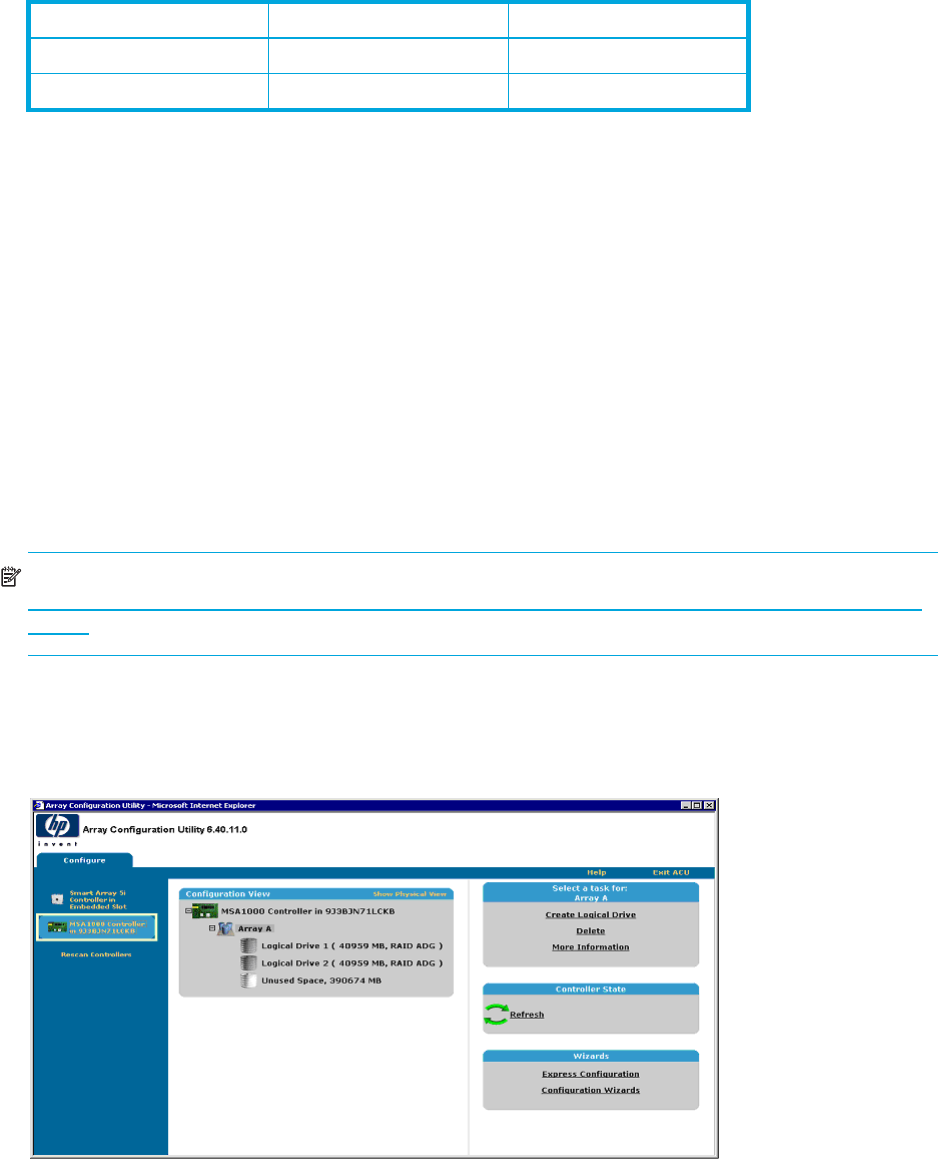HP StorageWorks External Storage XP user guide (T1706-96006, June 2006)
Table Of Contents
- HP StorageWorks External Storage XP user guide
- Contents
- About this guide
- 1 Overview of connecting external arrays
- 2 Preparing for External Storage XP operations
- System requirements
- External Storage XP requirements
- Installing External Storage XP
- Preparing for External Storage XP settings
- Powering arrays on or off
- Using mapped external LUs from the host connected to the local array
- Uninstalling External Storage XP
- Limitations on External Storage XP operations
- Figure 11 Example of external LU with 2 TB or less
- Figure 12 External LU capacity is larger than the specified emulation type’s basic capacity (OPEN-3 example)
- Figure 13 External LU capacity is smaller than the specified emulation type’s basic capacity
- Table 4 When external LU’s emulation type is OPEN
- Table 5 When external LU’s emulation type is for mainframes
- Combining External Storage XP with other HP StorageWorks products
- 3 Managing cache with external storage
- Guidelines for using cache with external storage
- Determining, setting, or changing the external LU cache mode
- Partitioning cache for external storage
- Determining the number and size of needed partitions
- Creating Cache partitions
- Changing storage system modes
- 4 External Storage XP panes
- 5 Configuring external LUs
- Overview of configuring external LUs
- Setting an external array’s port
- Setting a local array’s port attributes
- Mapping external LUs (Add LU)
- Setting alternate paths for external LUs
- Adding alternate paths by selecting multiple external LUs (Add Paths)
- Deleting alternate paths by selecting multiple external LUs (Delete Paths)
- Checking an external LU’s status (LDEV Information)
- Disconnecting external arrays or LUs
- Checking the connection status and resuming external LU operations (Check Paths & Restore Vol.)
- Restoring external LUs (LDEV Restore)
- Stopping the use of paths to an external LU by specifying an external array’s WWN (Disconnect Paths)
- Restoring paths to an external LU by specifying an external array’s WWN (Check Paths)
- Changing an external array’s port setting
- Stopping the use of paths to an external LU by specifying a local array’s port (Disconnect Paths)
- Restoring paths to an external LU by specifying a local array’s port (Check Paths)
- Deleting external LU mappings (Delete LU)
- 6 Troubleshooting NAS Blade systems that include external arrays
- 7 Remote command devices
- 8 Troubleshooting External Storage XP
- A Notes on connecting external arrays
- Connecting Thunder 9500V subsystems
- System parameters for connecting Thunder 9500V subsystems
- Relationship between serial numbers in the Device list on the LU Operation pane and Thunder 9500V subsystem models
- Relationship between the WWN of the port on the Thunder 9500V subsystem and the controller
- Path status and examples of recovery procedures (Thunder 9500V subsystems)
- Connecting TagmaStore AMS and TagmaStore WMS subsystems
- System parameters for connecting TagmaStore AMS and TagmaStore WMS subsystems
- Relationship between serial numbers in the Device list on the LU Operation pane and TagmaStore AMS and TagmaStore WMS subsystem models
- Relationship between the WWN of the port on the TagmaStore AMS or TagmaStore WMS subsystem and the controller
- Path status and examples of recovery procedures (TagmaStore AMS and TagmaStore WMS subsystems)
- Connecting XP12000/XP10000 Disk Arrays
- Connecting XP1024/XP128 Disk Arrays
- Connecting XP512/XP48 Disk Arrays
- Connecting HP 200 Storage Virtualization System as external storage
- Connecting EVA arrays
- Connecting Thunder 9500V subsystems
- B Required volume capacity for emulation types
- C Adjusting volume capacity for copy pair setting
- D Using an XP12000/XP10000/SVS200 with an EVA3000/5000 external storage
- E Configuring MSA1000/1500 as external arrays
- Index

156 Configuring MSA1000/1500 as external arrays
The following is a summary of the port setting status of the local array when you connect the MSA external
array.
Setting up the MSA
To set up the MSA for use as an external array connected to the XP12000/XP10000/SVS200, perform
the following steps:
1. Define the MSA Array Object.
2. Define the MSA LU.
3. Use MSA Selective Storage Presentation to institute LUN security.
After defining the MSA array object, specify individual storage LUs within the array object. At this point,
institute LUN security on the MSA using the ACU Selective Storage Presentation (SSP) functionality.
Use the HP StorageWorks Array Configuration Utility (ACU) to configure the MSA for its role as an
external array. ACU runs from a server attached to the MSA via a Fibre Channel path.
The MSA Array does not require any special firmware level or hardware additive to be usable by External
Storage XP as long as the firmware level in use supports the appropriate host mode setting (for example,
Windows or Tru64).
NOTE: Download the ACU and ACU Online User Guide from the following address:
http://h18004.www1.hp.com/products/servers/proliantstorage/software-management/acumatrix/ind
ex.html
Defining MSA array objects
Use the Array Configuration Utility (ACU) to define at least one internal MSA array object (for instance,
“A”) when first setting up the array. After defining an array object, specify LUs within that array object.
Figure 84 Defining MSA array objects with the ACU
Calculating MSA LU size and defining LUs
The ACU used for configuring the MSA uses an optimization algorithm to calculate the user size of a new
LU given a user-specified size in MB (Figure 85). Because you cannot bypass or disable the optimization
algorithm, you must compensate for this optimization so that MSA LUs are created at the correct size.
When requesting a new LU through the ACU, make the request 2 to 3 MB larger than needed for
Topology Fabric ON Fabric OFF
Loop Supported Supported
Point-to-Point Supported Not supported










